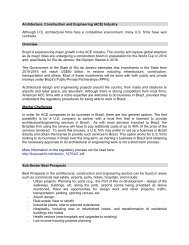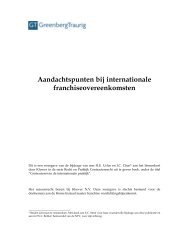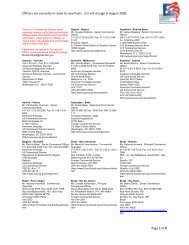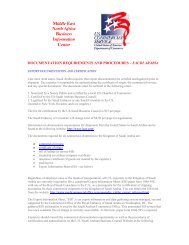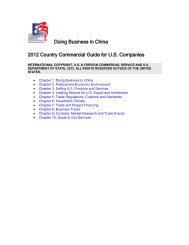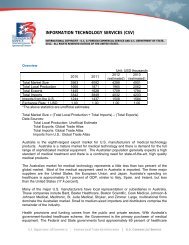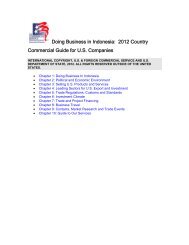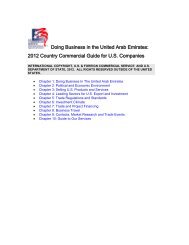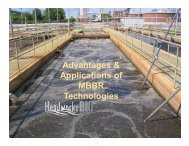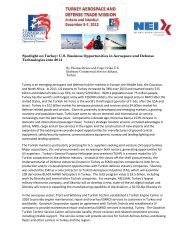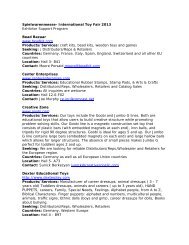2011 Bahrain Country Commercial Guide - US - Export.gov
2011 Bahrain Country Commercial Guide - US - Export.gov
2011 Bahrain Country Commercial Guide - US - Export.gov
Create successful ePaper yourself
Turn your PDF publications into a flip-book with our unique Google optimized e-Paper software.
Water Desalination<br />
Overview Return to top<br />
<strong>Bahrain</strong> is a desert island on the Zone C aquifer stretching all the way to Riyadh. Many<br />
years of heavy demand in Saudi Arabia and <strong>Bahrain</strong> have significantly depleted the<br />
aquifer, threatening its long-term viability and allowing seawater to infiltrate. The "sweet<br />
water" for which <strong>Bahrain</strong> was long famous is now brackish and requires treatment before<br />
use as drinking water or as process water for industry.<br />
<strong>Bahrain</strong> currently uses more than 110 million gallons of water per day, or 41.3 billion<br />
gallons per year. The local water supply comes mainly from non-renewable<br />
groundwater extraction. Supply barely exceeds demand; when routine maintenance<br />
work was performed in March 2007, there were rolling water shortages for several<br />
weeks. Two-thirds of <strong>Bahrain</strong>‘s water is supplied through desalinization, and the<br />
remaining third comes from the underground aquifer. Approximately 86 million gallons,<br />
desalinated and blended, are for drinking purposes. Industries, agriculture, and private<br />
gardens use the rest. Pilot projects are underway to use treated effluent for irrigation.<br />
The Government aims to have all agricultural water produced this way in the future.<br />
In October <strong>2011</strong>, the Higher Commission of Electricity and Water under the Ministry of<br />
Energy announced that it expected water consumption in <strong>Bahrain</strong> to reach an estimated<br />
140 million gallons per day by 2018. Current water project initiatives in the Commission<br />
budget involve the new Dour water production plant, a water pipeline from ALBA, and<br />
plant expansion for the Ras Abu Jarjur water desalinization facility. The Ras Abu Jarjur<br />
expansion is expected to yield an additional 16 million gallons of water per day. ALBA<br />
already supplies an estimated 7 million gallons per day to the national water network,<br />
and is expected to increase its supply to 9 million gallons by the end of next year.<br />
Best Prospects Return to top<br />
The Commission program to upgrade <strong>Bahrain</strong>'s desalination and effluent treatment<br />
infrastructure provides opportunities for U.S. companies. Increasingly, water and power<br />
production are being integrated through the construction of dual-use plants like those in<br />
Hidd and Manama. Water production through desalinization is an energy intensive<br />
procedure, making it ideal for integration with power generation facilities. The<br />
Government subsidizes 60-65 percent of the cost of water to consumers.<br />
<strong>Bahrain</strong> aims to reduce the abstraction of its scarce ground water resources by building<br />
a new water plant in the Hidd area, which will have the capacity to produce 60 million<br />
gallons per day. The current production at Hidd is 30 million gallons per day. The<br />
second phase of the Al Hidd desalination plant will be opened in the first quarter of<br />
2012..<br />
Opportunities Return to top<br />
The Commission program to upgrade <strong>Bahrain</strong>'s desalination and effluent treatment<br />
infrastructure provides opportunities for U.S. companies. Increasingly, water and power<br />
production are being integrated through the construction of dual-use plants like those in<br />
Hidd and Manama. Water production through desalinization is an energy intensive<br />
43





